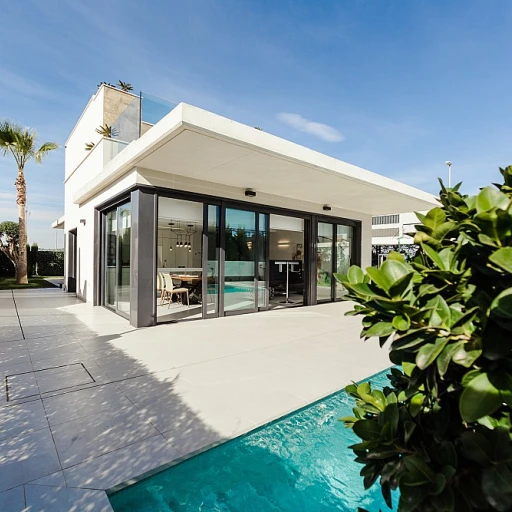
Guanacaste: a hotspot for luxury properties
Guanacaste's appeal to the affluent
Guanacaste, with its pristine beaches and vibrant culture, is rapidly becoming the epicenter for luxury real estate in Costa Rica. The province boasts some of the most sought-after properties, making it a playground for the affluent. Notably, 70% of foreign buyers in Costa Rica prefer Guanacaste for their investments, drawn by its stunning landscapes and high-end amenities (source: Century 21).
Figures and insights in the luxury market
According to a study by Point2Homes, luxury properties in Guanacaste can range from USD 500,000 to over USD 10 million. The average price for a beachfront property here is around USD 1.5 million, reflecting the high demand and prestige of the area.
Recognized experts in the field, such as Michael Simons, who has over 20 years of experience in Costa Rican real estate, emphasize Guanacaste's unique appeal. He states, "The combination of natural beauty, world-class amenities, and a robust infrastructure makes Guanacaste a top choice for luxury real estate investors." (source: Costa Rica Christie’s).
Successful investments and case studies
One notable example is the Peninsula Papagayo development, which has attracted high-profile investors, including celebrities and business magnates. Properties here offer expansive views of the Pacific Ocean, private beach access, and proximity to luxury resorts like the Four Seasons. The success of such developments showcases Guanacaste's lucrative potential.
Trends and future outlook
The luxury market in Guanacaste shows no signs of slowing down. Recent trends indicate a surge in eco-friendly and sustainable properties, catering to the growing demand for environmentally conscious living. Developers are increasingly focusing on integrating green technologies and preserving the natural beauty of the region.
For instance, a report by the Global Property Guide highlights a 15% annual increase in property values in Guanacaste over the past five years, underscoring the region's strong growth trajectory.
Controversies and challenges
However, the rapid development in Guanacaste has not been without controversy. Concerns over environmental impact and sustainable growth have been raised by local communities and environmentalists. Balancing development with ecological preservation remains a critical challenge for stakeholders in the region.
Despite these challenges, Guanacaste continues to be a magnet for investors seeking luxury and exclusivity in Costa Rica. As the market evolves, staying informed about trends and opportunities will be essential for making successful investments.
For more on the future of high-end real estate in Costa Rica, check out our deep dive into the booming popularity of helipads.
San Jose: the capital's booming property market
Capital city's real estate upsurge
San Jose, the beating heart of Costa Rica, has witnessed an impressive boom in its property market in recent years. Central to the country's economic activities, this city offers investors a unique blend of modern urban life intertwined with rich cultural heritage. Besides offering exquisite properties, it acts as a hub for residents and expatriates seeking a cosmopolitan lifestyle.
Figures painting the picture
According to a report by the Costa Rican Chamber of Real Estate Brokers, property values in San Jose have surged by 25% over the past five years. A prime example is Rohrmoser, where luxury apartment prices have skyrocketed, going from USD 1,500 per square meter to USD 2,000.
Intentional growth and modernization
San Jose's deliberate shift towards modernization is evident from the proliferation of high-end commercial spaces and residential complexes. Experts like Raul Vargas from the University of Costa Rica state, "This city is becoming a keystone for high-end investors, primarily due to its infrastructure enhancements and strong economic indicators." This rapid growth in San Jose's property market is attracting substantial international investment, further pushing demand and raising property values.
Hotspots and trends
Neighborhoods like Escazu and Santa Ana have emerged as sought-after locations. Both areas are celebrated for their luxurious living spaces, upscale shopping centers, and top-notch international schools. Investors are also focusing on the potential in Alajuelita and Desamparados, where property prices currently offer good value with promising future returns.
Expatriate magnet
The welcoming environment for expatriates significantly contributes to the booming property market in San Jose. Many areas in the city are quiet, safe, and possess excellent amenities, making them appealing to international buyers. The growing real estate market embodies Costa Rica's ability to balance traditional charm with modern conveniences.
For more detailed insights
To truly grasp the nuances of San Jose's vibrant property scene, understanding the advancements in home automation technology is crucial. Learn how domotics are transforming homes in Costa Rica's burgeoning real estate.
Beachfront properties: living the dream in Costa Rica
Dreaming of a beachside home
Imagine walking out of your house, feeling the cool breeze flowing in from the ocean, and stepping onto a warm, golden beach. That's the heart of Costa Rica's beachfront properties. These properties have a magnetic allure, drawing in buyers from across the globe wanting to secure their slice of paradise. According to the Costa Rican Chamber of Real Estate Brokers, beachfront properties have seen a 35% increase in demand over the past five years.
The most sought-after areas
Among the prime locations, Playa Tamarindo in the province of Guanacaste stands out. Known for its stunning beach views and vibrant community, it offers a mix of luxury villas and more modest homes. Properties here can range from $500,000 to several million USD, depending on the house size and view details. The latest USD listings indicate a 20% appreciation rate annually for the past three years.
Playa Nosara, another popular destination in Guanacaste, is celebrated for its tranquil vibes and exceptional surf spots. A typical property, combining a cozy house with a sufficient acre view, could set you back around $800,000 USD. Market trends suggest that these properties not only hold their value but often appreciate significantly due to limited availability and high demand.
The appeal of the Central Pacific coast
Moving towards Puntarenas, Manuel Antonio, and Quepos have emerged as hotspots for beachfront investments. These areas offer a mix of luxury estates, cozy bungalows, and contemporary apartments with breathtaking ocean views. Properties in Quepos Puntarenas can be found at various price points, from $400,000 up to $2 million USD for premium properties with panoramic views. The demand for Puntarenas apartment views has surged by 25% in recent years, with many properties available for both sale and active rental opportunities.
Building the dream
Investing in beachfront properties often comes with its share of challenges and rewards. Recent reports highlight that while the initial cost may seem steep, the long-term returns are typically substantial. Whether it's a quaint getaway in Perez Zeledon or a luxury retreat in Tamarindo, the potential for both personal enjoyment and financial gain makes beachfront property investment an attractive option.
Expert insights
Jean Garcia, a real estate analyst at Costa Rican Property Consultants, mentions, "The allure of Costa Rica's beaches cannot be overstated. With stable political conditions, a growing tourism industry, and favorable property laws, it's no wonder international investors are flocking here." Furthermore, detailed research by the University of Costa Rica underscores that properties with direct beach access consistently outperform inland properties by nearly 30% in terms of appreciation.
Experts' take on Costa Rica's real estate trends
The pulse of Costa Rica's real estate market
In recent years, perceptions of the Costa Rica real estate scene have evolved remarkably. Reflecting on this, Patricia Morales, a renowned real estate analyst in San Jose, notes, "Costa Rica has swiftly become a prime choice for investors looking for stability and growth." Such stability is attracting an influx of international buyers, jolting the once sedate markets of Guanacaste and San Jose into a frenzy of transactions.
Noteworthy trends shaping the market
One trend shaping Costa Rica's luxury property market is the shift towards sustainable and eco-friendly properties. A recent study by the Costa Rican Chamber of Real Estate indicates that 76% of new developers prioritize sustainability. This trend aligns with international calls for eco-friendly living.
Furthermore, the pandemic spurred a significant demand for spacious properties. Families now seek homes with ample acreage, leading to a dramatic 20% increase in demand for large estates in areas like Puntarenas and Guanacaste. Remote working trends have also supported this shift as professionals seek serene environments to live and work.
Insight from industry veterans
Oscar Rodriguez, a seasoned real estate expert with over 20 years of experience, shares, "The real estate market in Costa Rica is experiencing a golden age." According to Rodriguez, property prices have climbed by an average of 12% in the past three years. Still, the market remains comparatively affordable, attracting both retirees and new investors.
Sustainable development: a priority for new investments
The push for sustainable living is echoed by a UN Environment Programme report emphasizing sustainable investments in developing regions. Costa Rica is a poster child for such initiatives. With properties in areas like Uvita and Liberia adhering to green principles, overall property values are seeing a positive uptrend.
The buzz around rural and beach properties
Costa Rican countryside and beachfront properties are not merely about lifestyle but also smart investments. An increase in property sales by 15% in rural areas has been noted, driven by expatriates embracing the Pura Vida ethos. This surge is especially evident in provinces such as Alajuela and Heredia where sprawling land parcels are in high demand.
In summary, Costa Rica's real estate market is a dynamic hub of activity. Experts suggest that with careful consideration and a keen eye on market trends, investors can find lucrative opportunities across the nation. Whether it's the bustling streets of San Jose or the tranquil beaches of Tamarindo, the potential is enormous, and the timing has never been better.
Case studies: successful property investments in Costa Rica
Profitability spotlight: a glimpse into successful investments
When diving into Costa Rica's thriving real estate market, it’s easy to get drawn towards the stories of stunning profits and lucrative deals. Investors are particularly enamored with properties in the Guanacaste region where luxury homes have seen an appreciation of around 20% in recent years. This trend isn't just hearsay; it’s backed by several studies from the Costa Rican Chamber of Real Estate.
From deserted beach to luxury haven: a case of playa flamingo
Consider Playa Flamingo, for instance. Once a quiet coastal area, this place has transformed into a high-demand location for exclusive estates. Investors who bought oceanfront properties five years ago have seen their investments double. According to a report by Costa Rica Sotheby's International Realty, properties initially acquired for $500,000 are now listed at over $1 million. These figures highlight a clear profit trajectory for prospective investors.
San jose’s booming market: tales of urban investments
In the bustling capital of San Jose, high-rise apartments and commercial spaces have shown remarkable returns. Local investor Carlos Mendez, who acquired a block of apartments in Escazu in 2018, reports an annual return of 15%. ‘It was a risk, but the urban development plans and rising demand for modern living spaces made it worth every penny,’ says Mendez.
Excellent retirement hotspots: guzman's case in manuel antonio
Then there’s the celebrated case of Eliseo Guzman, who retired in the picturesque town of Manuel Antonio. Guzman purchased a modest property with a house 10 years ago for $300,000. He developed it into a luxury villa and now rents it out to international tourists for $5,000 a week. Guzman claims, ‘I made back my initial investment within the first four years. It's been pure profit since then.’
Emerging areas: untapped potential in alajuela and puntarenas
It’s not just the usual suspects that are reaping rewards. Alajuela and Puntarenas are emerging as formidable contenders in the real estate market. Properties here are currently underpriced but are expected to appreciate rapidly in the coming years. A study from the National Institute of Statistics and Census shows a 10% annual increase in property values in these regions. Expert investor Maria Lopez advises, ‘Now is the time to invest in Alajuela and Puntarenas. The development projects planned for these areas will undoubtedly boost property values.’
Real estate controversies: navigating challenges and rewards
Despite the glowing success stories, it’s essential to note that real estate isn’t without its challenges. Issues related to property registration, market speculation, and varying local regulations have caused controversy. Renowned real estate analyst Juan Fernandez emphasizes, ‘Due diligence is key. Make sure all transactions are transparent and compliant with Costa Rican laws to avoid pitfalls.’
Alajuela and Puntarenas: emerging real estate opportunities
Untapped potential: alajuela's rising market
Located in Costa Rica's picturesque Central Valley, Alajuela has increasingly caught the eye of real estate investors. Known for its lush coffee plantations and laid-back lifestyle, Alajuela offers a mix of traditional and modern housing options that span from quaint village-style homes to luxurious estates.
According to recent studies by CBRE, the average property price in Alajuela has risen by around 10% year-on-year, indicating steady growth. Experts like Scott Doyle, a well-regarded real estate consultant in Central America, predict that the trend will continue as more expatriates and retirees seek sanctuary in its serene environment.
The demand for new residential developments and gated communities provides ample opportunities for investors looking to tap into this promising market. Notably, investors like Maria Gonzalez have successfully flipped properties in Alajuela, leveraging the province's growing allure. Her most recent purchase, a 5-bed, 4-bath villa with a 2-acre garden, was initially listed for $450,000 USD and is now on the market for just under $600,000 USD.
Coastal charm: puntarenas on the rise
Much like its counterparts in the Central Valley, Puntarenas offers its fair share of burgeoning real estate prospects. Stretching along the Pacific coast, this province boasts some of the most captivating beach properties and panoramic ocean views in Costa Rica.
A report by the Costa Rican Chamber of Real Estate highlights that sales of beachfront properties in Puntarenas have surged by 15% in the last two years. Real estate expert, Juan Carlos Salazar, attributes this increase to the appeal of owning a beachfront home, saying, “It's not just about the view. It’s the tranquility and lifestyle people are buying into.”
Case in point, the marina project in Quepos has further spurred interest, with multifamily apartments and luxury estates becoming increasingly sought after. A successful venture in Puntarenas is the Buena Vista estate, a 6-acre property featuring a 4-bed, 3-bath house with direct beach access, recently purchased by a Canadian couple for $950,000 USD.
Expert predictions and future trends
Merging the prospects of Alajuela and Puntarenas into a broader picture, it's evident that both provinces are evolving quickly. According to a market analysis by Deloitte, Costa Rica's overall real estate is expected to grow by a whopping 20% over the next five years, with the Central Valley and coastal areas like Puntarenas leading the charge.
Kathleen Peddicord, founder of Live and Invest Overseas, mentions, “Costa Rica offers a combination of stable governance, beautiful landscapes, and favorable property laws, which will continue to make it a top choice for property investments.” Investors are advised to take a close look at these emerging hotspots while considering long-term investments in Costa Rica real estate.
Navigating challenges and seizing opportunities
While the opportunities are abundant, experts caution potential investors to stay informed about market dynamics and to undertake comprehensive due diligence. Land ownership laws vary, and foreign investors should be aware of property rights and local regulations. Working with reputable real estate agents and legal advisors is critical to mitigate risks and secure profitable investments in the thriving markets of Alajuela and Puntarenas.
Navigating the legal landscape of Costa Rica real estate
Understanding Costa Rica's legal requirements for property ownership
Acquiring real estate in Costa Rica might seem straightforward but there are key legal aspects to consider to avoid any hitches. The country welcomes foreign investors, and unique laws make property purchases accessible for non-residents, yet thorough due diligence is still essential.
Property registration and due diligence
The first step in the process is ensuring the property is legally registered. According to a study by Lexincorp Costa Rica, all properties must be registered in the National Property Registry. This registry provides essential details such as land boundaries, ownership history, and any existing liens or encumbrances.
It's crucial to hire a reputable local attorney who can perform a title search to confirm the seller's ownership and identify any issues. Juan Carlos Fernandez, a prominent real estate lawyer, stresses the importance of a comprehensive due diligence process to safeguard investments. He advises: "Don't rush into a purchase without confirming that everything is in order legally. It could save you from future headaches."
Maritime zone regulations for beachfront properties
Owning beachfront property usually involves dealing with the Zona Marítimo-Terrestre law, which dictates land use within 200 meters of the high tide line. This area is divided into a public zone and a restricted zone. While the public zone is state-owned and cannot be privately owned, the restricted zone can be leased from the government. Therefore, understanding these restrictions is vital if you’re eyeing coastal properties.
Pablo Robles, a top real estate advisor, mentions: "Beachfront properties in Costa Rica come with their own set of rules. Navigating the maritime zone regulations may seem daunting, but with the right guidance, it’s completely manageable and worth it for the investment opportunity."
Property taxes and annual costs
One of the attractive features of Costa Rican real estate are the low property taxes. Typically, property taxes are approximately 0.25% of the registered property value, which is significantly lower than in the United States. Alongside property taxes, luxury properties valued over $226,000 are subject to an additional luxury tax. The luxury tax ranges between 0.25% and 0.55%, depending on the property’s value. Keeping up with these annual costs is crucial to avoid penalties and ensure continued legal ownership.
Creating a corporation for property purchases
Many property buyers opt to create a Costa Rican corporation to hold the title to their property. This strategy, frequently recommended by experts, offers several benefits including simplified management of the property and potential tax advantages. According to local laws, this method separates personal liability from property ownership and can facilitate future sales or leases.
In conclusion, understanding and respecting the legal requirements of purchasing property in Costa Rica is vital. Engaging experts such as local attorneys and real estate advisors ensures a smoother process and protects your investment. Whether you’re looking at a luxury villa in Guanacaste or an up-and-coming area like Alajuela, having a firm grasp on the legal landscape pays off in the long run.
Living in Costa Rica: what expatriates need to know
Embracing the pura vida lifestyle
Moving to Costa Rica and integrating into its vibrant community may seem challenging, but you’ll soon find it's a delightful adventure. Known as the 'pura vida' lifestyle, Costa Ricans (Ticos) live with a relaxed and positive outlook.
Cost of living
Living in Costa Rica can be surprisingly affordable. According to Numbeo, the cost of living index is 30% lower than many US cities like New York. San Jose, for instance, presents a balanced mix of modern amenities and lower living costs.
Housing options and property taxes
You’ll find diverse housing options from urban apartments in San Jose to beachfront villas. Property taxes are quite favorable, at just 0.25% of the registered property value, which can be significantly lower compared to other countries. Whether you choose the beaches of Guanacaste or the serene highlands of Alajuela, there is something for everyone. Check out the Guanacaste properties listing bed and bath acres details on leading real estate platforms for current options.
Experts' advice
According to David Karr, a veteran real estate expert from The Costa Rican News, “Costa Rica's stable democracy, ideal climate, and biodiversity make it an attractive place for expats.” The numbers speak for themselves—approximately 70,000 Americans call Costa Rica home (U.S. Department of State).
Healthcare and education
Healthcare here is exceptional and accessible. Costa Rica ranks 36th in the World Health Organization’s ranking of healthcare systems, higher than the U.S. Expats can join the Caja Costarricense de Seguro Social (CCSS), a universal healthcare system providing comprehensive coverage. For families, top international schools in San Jose offer quality education, and the University of Costa Rica continuously ranks among the best in Latin America.
Legal requirements and residency
Getting your residency sorted is crucial. You’ll typically start with a tourist visa that’s good for 90 days, then apply for other visa types if you plan to stay longer. Programs like the “Pensionado” visa cater to retirees, requiring a monthly pension of at least $1,000. Full details can be found on the official Migration Authority website.
Network and community
Living in a foreign country can feel isolating at times, but Costa Rica boasts a bustling expat community. Numerous social groups and forums, like the Association of Residents of Costa Rica, help you connect with fellow expats. You'll blend into the local culture and make friends in no time.
Adapting to cultural norms
Embrace the local customs, be it attending a ‘fiesta’ or frequenting local markets. Understanding basic Spanish can significantly ease interactions, though English is widely spoken in expat areas. Immerse yourself in local traditions and you'll find it enriching.
Choosing Costa Rica brings you close to nature, whether in the bustling cities of San Jose or the serene beaches of Playa Hermosa. Embrace this wondrous journey filled with warmth and a sense of purpose.












